Neon Spectral Lamp, USB Powered

- Stable Spectral Lines (500 nm - 1100 nm) Useful for Wavelength Calibration
- Long Lifespan: 10 000 Hours (Typical)
- Output Accepts SMA Connectors
- Direct and Remote Control via USB
CSL1
Neon Spectral Lamp
The main peaks of the neon spectrum emitted by the CLS1 Lamp are engraved on the top of the housing.

Please Wait
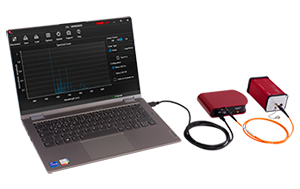
Click to Enlarge
Light from the CSL1 Neon Lamp is detected by the CCS175 Spectrometer. The measured neon spectrum can be compared to the NIST spectral lines to verify the accuracy of the spectrometer.
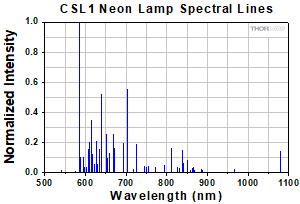
Click to Enlarge
Click for Raw Data
The peak wavelengths of the neon spectral lines produced by the CSL1 lamp match the peaks listed in the NIST spectroscopic database. The data was normalized by setting the intensity of the strongest emission line at 585.249 nm to 1.
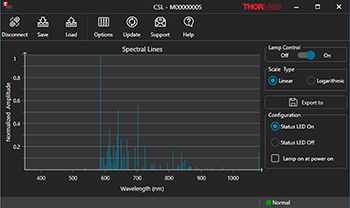
Click to Enlarge
The CSL software provides a simple GUI that can be used to control the lamp and display the internal NIST data.
Features
- USB-Powered Lamp Useful for Wavelength Calibration of Spectrometers
- Neon Spectral Lines Cover the 500 - 1100 nm Wavelength Range
- Direct and Remote Control via USB 2.0 with Included Software
- Integrated Identification Chip (EEPROM) Stores NIST Spectral Data
- SMA905 Fiber-Coupled Output with Protective Cap
- Compact Form Factor
- USB 2.0 Type-A to Mini-B Cable Included (1.5 m Length)
Thorlabs' CSL1 Neon Spectral Lamp is a USB-powered neon light source that produces stable, well-defined spectral lines within the 500 nm to 1100 nm wavelength range. With peaks that match those listed in the NIST spectroscopic database, this lamp is ideal for wavelength calibration of spectroscopic equipment, including Thorlabs' Compact CCD Spectrometers, Modular Raman Spectroscopy Kit, and Optical Spectrum Analyzers.
The output of the lamp accepts SMA905- and SMA906-terminated multimode fibers and is designed so that the connected fiber will be positioned as close as possible to the emitter, thereby minimizing losses at the fiber input and maximizing output power. The properties of the fiber used should be selected based on the application, such as the requirements of the spectrometer being calibrated.
This spectral lamp is powered using the mini-B USB port on the back panel of the housing. For remote control with the CSL software, the lamp must be connected to a standard PC USB type-A port. This provides both power and the USB 2.0 protocol needed to control the device. To operate the lamp manually, connect the device to a suitable 5 V DC power source; see the Specs tab for details. The lamp can then be controlled directly via the power button on the front panel of the housing. A USB-AB-72 USB 2.0 type-A to mini-B cable is included with each device; alternatively a compatible USB cable with an M2.5 locking screw, such as the USB-ABL-60 cable, can be used to protect against accidental disconnection.
A status LED indicator is included on the front panel to easily identify the operation status of the lamp. When the lamp is powered but in standby mode, the LED appears blue; the LED appears green when the lamp is powered and turned on. The LED can also blink red to indicate an error; see the lamp manual for more details.
PC Control
The CSL software package allows for remote control of the CSL1 Neon Spectral Lamp. The user-friendly interface includes controls for turning the lamp on and off and displaying the NIST spectral lines for neon stored in the device's internal memory, which can be shown on a linear or logarithmic scale. The GUI also allows the user to turn off the status LED to reduce background light, set the lamp to immediately turn on upon connection to power via the USB port, and view how long the lamp has been used and the total lamp lifetime. For more information on the CSL software, please see the Software tab.
| Item # | CSL1 |
|---|---|
| Wavelength Range | 500 - 1000 nm |
| Amplitude Stabilization | <1 Minute |
| Lifetime | 10 000 Hours (Typical) |
| Power Management Interface | |
| Input/Output Interface | Mini-B USB Connector |
| Operation Protocol | USB 2.0 |
| DC Input | 5 V |
| Power Consumption | <1.5 W |
| Fiber Compatibility | |
| Fiber Connector | SMA905 |
| Maximum Aperturea | 3.0 mm |
| Compatible Optical Fiber Connectors | SMA905 and SMA906 |
| Remote Control Interface | |
| Remote Interface | USB 2.0 (High Speed) |
| Connector | Mini-B USB, Lockable |
| General Specifications | |
| Operating Temperature Rangeb | 0 to 40 °C |
| Storage Temperature Range | -40 to 70 °C |
| Relative Humidity (Max) | 80% up to 31 °C, Decreasing Down to 50% at 40 °C |
| Dimensions (W x H x D) | 115.1 mm x 59.7 mm x 47.0 mm (4.53" x 2.35" x 1.85") |
| Weightc | 294 g |
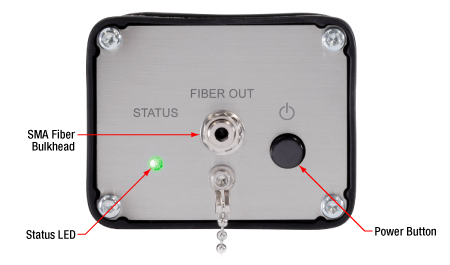
Click to Enlarge
CSL1 Neon Spectral Lamp Front Panel
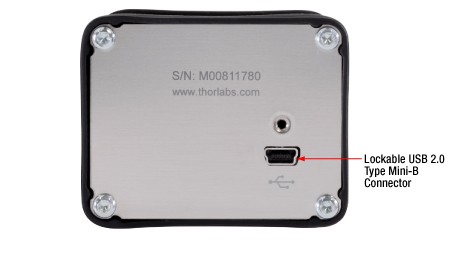
Click to Enlarge
CSL1 Neon Spectral Lamp Back Panel
| Recommended System Requirements | |
|---|---|
| Operating System | Windows® 7 (32 Bit, 64 Bit), Windows® 10 (64 Bit), Windows® 11 (64 Bit) |
| Processor (CPU) | 1 GHz or Higher |
| Memory (RAM) | 512 MB |
| Hard Drive | 200 MB (Min) of Available Disk Space |
| Graphics Card Resolution |
1280 x 768 (Min) |
| Interface | Free USB 2.0 Port |
Software
Version 1.0.1
This software package provides a GUI to control the CSL1 Neon Spectral Lamp. To download, click the button below.
CSL Software
The CSL Software provides full control over the CLS1 Neon Spectral Lamp, allowing the user to power the lamp on and off, turn off the status LED to reduce background light, set the lamp to immediately turn on upon connection to power via the USB port, and monitor the lamp operation time. The NIST spectrum displayed in the GUI, which is saved on the CSL1 EEPROM, can be exported as a .csv file.
| Posted Comments: | |
Junyu Li
(posted 2024-08-06 16:31:54.427) Hello, is this neon lamp filled with argon gas? Some spectral characteristic peaks similar to argon were measured achoorakuttil
(posted 2024-08-06 09:05:46.0) Dear Junyu,
Thank you for your feedback.
It has been observed that the lamp may contain trace amounts of other noble gases like Argon. These lines tend to disappear with active usage.
I have reached out to provide additional information. junyu li
(posted 2024-07-19 10:50:45.57) Can the power output stability of this light source reach 1%? We want to use this calibrated light source to compare the sensitivity of different spectrometers. Junyu Li
(posted 2024-05-07 16:48:19.883) Hi, Can this calibration light source calibrate the HG10 (https://www.thorlabs.com/newgrouppage9.cfm?objectgroup_ID=15359)spectrometer? If not, what calibration light source does the HG10 need to use to calibrate the wavelength? soswald
(posted 2024-05-08 05:23:42.0) Dear Yunyu,
thank you for your feedback.
We use the CSL1 in our production for the factory calibration of the HG10.
I have reached out to you to discuss this in more detail. Richard Graham
(posted 2024-02-27 10:48:01.193) I don't seem to be able to see any indication of the actual optical power output from this unit in the specifications. I understand it may vary considerably depending on the type of fiber and spectral range considered, but perhaps you could give an example based on a recommended multi-mode fiber? I am also considering operating this with a single mode fiber, this will naturally be much less efficient and it would be useful to have some starting point to estimate it it is viable for my application.
It would also be useful to provide a brief description of the construction of the unit, such as the type of lamp, total output, and type of coupling solution used. Is there an internal fiber between the lamp and SMA bulkhead, and if so, what type? soswald
(posted 2024-02-28 03:46:29.0) Dear Richard,
thank you for your feedback.
We measured 125 nW output power with a 400 µm core diameter multimode fiber with 0.39 NA. Please note that this is a typical value we only tested with one unit and not a guaranteed specification.
There is no internal fiber between the bulb and the SMA bulkhead. Hitesh Mamgain
(posted 2023-06-23 16:39:19.273) Do you have the same unit with HgAr Lamp for calibration in the UV - VIS? hkarpenko
(posted 2023-06-23 06:06:07.0) Dear Hitesh,
thank you very much for your feedback. At the moment we only offer this neon spectral lamp with emission from 500nm - 1000nm. But we are working on options for the UV range for the future. user
(posted 2023-06-07 09:37:05.547) Mercury/Argon version of this lamp would be useful also. soswald
(posted 2023-06-07 07:25:19.0) Thank you for your feedback. We are currently looking into possible extensions of the spectral lamp product line to different wavelength ranges and mercury/argon is certainly one of the options we are considering.
At the moment unfortunately we cannot give an exact timeline on when the next part of this product family will be added and which gases we will ultimately choose next. André Weber
(posted 2022-10-12 16:26:30.74) Hi.
Why is the spectral range of your Neon lamp long pass filtered from 500nm?
Is it possible to get the weak lines below 500nm out, too? e.g. 470.44nm or 359.35nm, when removing the fiber.
Thank you so much!
André soswald
(posted 2022-10-13 08:00:41.0) Dear André,
thank you for your feedback. The two spectral lines you mention are emitted by the CSL1. There is no longpass filter installed in the unit and the fiber we use is also transmissive for these wavelengths.
However, the lines above 500 nm, namely the dominant line at 585.25 nm have a much higher intensity than the lower wavelength region. Depending on the instrument you wish to calibrate a low-pass filter might be helpful in blocking the lines above 500 nm and only using those below 500 nm. |
 Products Home
Products Home









 Neon Spectral Lamp
Neon Spectral Lamp